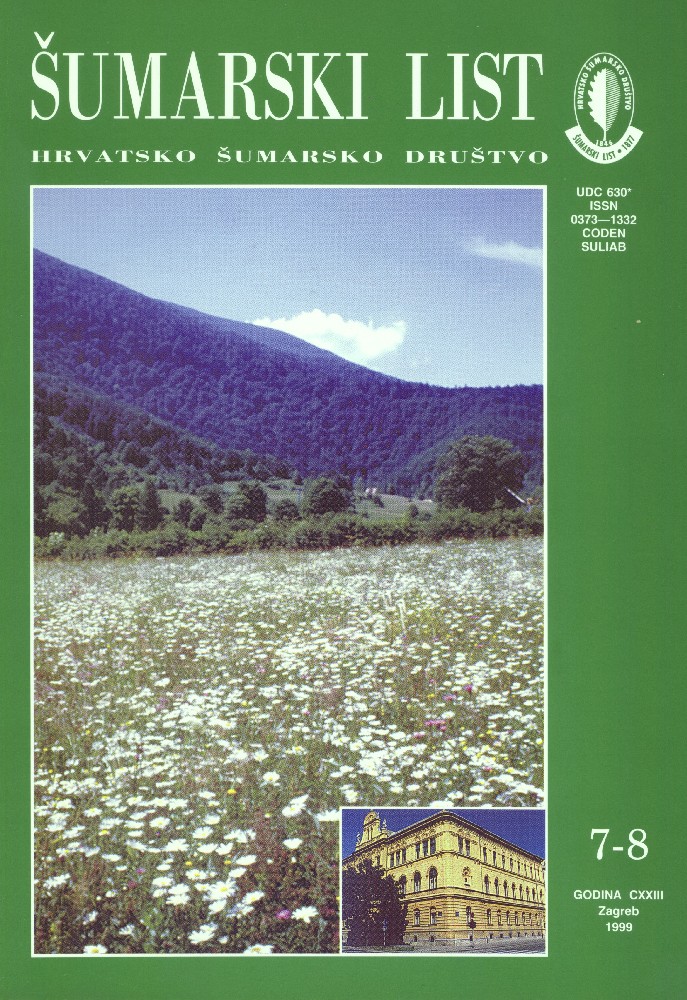
broj: 7-8/1999
pdf (27,1 MB) |
|
||||||||||||||
| IZVORNI ZNANSTVENI ČLANCI | ||
| Vukelić, J., Baričević, D., Perković, Z. | UDK 630* 188 + 907 (001) | |
| Vegetative and Other Characteristics of the Protected Part of "Slatinske podravske šume" pdf HR EN | 287 | |
| Topić, V. | UDK 630* 232 + 232.1 + 233 (001) | |
| Surface Excavation in the area of Kaštela and the Possibilities of their amelioration pdf HR EN | 301 | |
| PRETHODNO PRIOPĆENJE | ||
| Trinajstić, I., Franjić, J. | UDK 630* 188 | |
| Beech forests with ciliated reed grass (carici pilosae-fagetum Oberdorfer 1957) in the vegetation of Croatia* pdf HR EN | 311 | |
| Summary: By the plantsociological and syntaxonomical analysis of mesophillic beech forests on the mountains extending between the Sava and Drava Rivers (Bilogora, Moslavačka gora, Papuk) in Croatia, large areas have been found to be covered by the beech forest with ciliated reed grass (Carici pilosae-Fagetum Oberdorfer 1957), as a very striking forest association. In the Croatian forestry plantsociological literature, the said forest association has been designated for years by the name of "Carici pilosae-Fagetum Pelcer, prov." or shorter "Carici pilosae-Fagetum Pelcer", that is illegitym, since the combination "Carici pilosae-Fagetum" has been used for the first time by Oberdorfer (1957).During his investigation of beech forests, Matić et al. (1979) designated this association by the name of "Fagetum croaticum montanum Horv. 38", and he studied it thoroughly in his work "Forest Vegetation Reserve Prašnik and Muški bunar". By comparing the beech forest floral composition of mountains between the Sava and Drava Rivers in Croatia designated by the name of "Carici pilosae-Fagetum Pelcer, prov." (Pelcer 1979, 1983) and the Central European stands designated by the name of "Carici pilosae-Fagetum Oberd. 1957" (Oberdorfer 1957), namely Galio odorati-Fagetum "Carex pilosa - Ausbildung" (Th. Müller 1992), it can be seen that all three complexes are spread over a relatively large space in Centaral Europe with basically a unique floral composition and that they fit well in the frame of the Centaral European alliance Fagion sylvaticae, and inside it in the suballiance Galio odorati-Fagenion. Similary, for the Croatian stands it is significant that practically they do not contain any elements of the Illyrian alliance Aremonio-Fagion, and, therefore, they fit very well into the frame of the Central European alliance Fagion sylvaticae, too. For these reasons, we accepted the original standpoint of Oberdorfer (1957) that the beech forest stands in which Carex pilosa predominates are to be understood as an independent association of Carici pilosae-Fagetum. It should be noted, however, that in Croatia, as well as elsewhere in Europe, the ass. Carici pilosae-Fagetum is in the close sindynamical and sinchorological relations with the ass. Galio odorati-Fagetum, taken in a limited sense, with which there is no doubt that floristically it is closely related. Key words: Carex pilosa; Fagus sylvatica; Croatia | ||
| PREGLEDNI ČLANCI | ||
| Harapin, M. | UDK 576.89 | |
| Ticks and some anthropozoonoses pdf HR EN | 323 | |
| Kružić, T. | UDK 630* 679 | |
| development of computerized information system in Croatian forestry pdf HR EN | 329 | |


